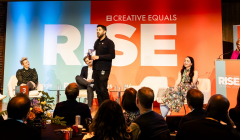
Are we leaving men and boys behind?
At Creative Equal’s RISE event, industry leaders consider how to reframe boys and men in marketing

Ahead of World Cancer Day we lift the lid on how the ‘Paintings of Hope’ campaign used AI to change drug approval laws.

Breast Cancer is one of the world’s most frequently diagnosed cancers. Yet the uncomfortable truth is within a media narrative dominated by an individual’s resolve to ‘fight’ cancer, secondary breast cancer, or metastatic breast cancer (MBC) does not get the attention it needs.
When it comes to MBC there is often not a happy ending. The average life expectancy is 3 years from diagnosis. For patients diagnosed with metastatic triple-negative breast cancer, a strain of MBC, that life expectancy drops to just one year.
To not only break the silence on this often untold story, but help change drug approval laws, VMLY&R Health and Gilead turned to AI and the power of creativity to not just change the narrative, but to successfully change legislation is Spain surrounding drug approval times. A move in turn which could help to change outcomes for those with Breast Cancer.
Paintings of Hope shows the more emotional side of AI. It also demonstrates the meaningful outcomes that we can achieve when creativity and technology combine for a purpose.
Natxo Diaz, Chief Creative Officer of VMLY&R Health Spain
As we approach World Cancer Day there is no question that awareness and support for Breast Cancer is high, the fact remains that understanding and research into secondary forms of the disease is much lower.
Furthermore, MBC patients in Spain were denied access to critical treatments due to the country’s longer drug approval times (when compared with the rest of Europe). With survival rates low, every day spent waiting for treatment matters.
To help tackle this challenge VMLY&R Health and Gilead created the ‘Paintings of Hope’ exhibition to demonstrate that there’s still plenty of life in patients, despite their prognosis.
The campaign raised awareness of inequities in access to medicines, and the emotional impact this has on patients. ‘Paintings of Hope’ helped change the laws in Spain, ensuring approval times were brought in line with the European benchmarks. The legislative change gives MBC patients faster to access vital treatments.
The paintings were created using AI technology, which turned the feelings and hopes of patients into real life paintings. Three patients shared their own personal accounts of the realities of living with the disease. VMLY&R Health and Gilead then used AI and sound analytics to convert the interviews into sound waves. These waves were interpreted by a specially trained AI robot, which reproduced them on canvases as paintings. Turning the patients’ testimonies into art.
Natxo Diaz, Chief Creative Officer of VMLY&R Health Spain, explained: “Paintings of Hope shows the more emotional side of AI. It also demonstrates the meaningful outcomes that we can achieve when creativity and technology combine for a purpose. The exhibition, quite literally, enables our audience to look this disease in the eye.”
The nationwide media attention the campaign generated brought the issue to the attention of both the Spain government and the health community at large. The campaign achieved coverage across press, social and TV, achieving over 95.4 million reach with a media value of over €7.48M.
The travelling exhibition was also hung in the entrance to the Spanish Parliament as patients and campaigners, many of whom helped to create the work, joined forces to speak to Parliament on October 13th - World Metastatic Breast Cancer Day. Shorter approval times for drugs, including those used to treat MBC, were subsequently agreed by the Spanish Congress.
In a media narrative in which AI is often pitted against the humans driving creativity this campaign eloquently underlines that not only is it possible for the two to work hand in hand but that you can elevate the impact of the work in the process.
Looks like you need to create a Creativebrief account to perform this action.
Create account Sign inLooks like you need to create a Creativebrief account to perform this action.
Create account Sign in